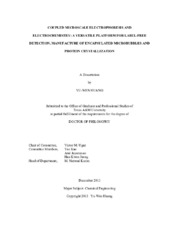| dc.contributor.advisor | Ugaz, Victor | |
| dc.creator | Huang, Yu-Wen | |
| dc.date.accessioned | 2014-05-13T17:22:03Z | |
| dc.date.available | 2015-12-01T06:31:16Z | |
| dc.date.created | 2013-12 | |
| dc.date.issued | 2013-12-12 | |
| dc.date.submitted | December 2013 | |
| dc.identifier.uri | https://hdl.handle.net/1969.1/151751 | |
| dc.description.abstract | Microfluidics has geniuses of low consumption of reagents and sample, miniaturization of device, and fast turnaround time for analysis that enables to develop high-speed, high-resolution, portable bio-analysis devices to be immediately used at the point-of-care and homebased assays. Here, we established a versatile microfluidic system incorporating micro-arrays of individually addressable electrodes (patterned along the microchannel floor, 50 µm wide, 250 µm edge-to-edge spacing) that make it possible to transport charged macromolecules from the bulk solution to an electrode surface where they become compacted into an ultra-thin film. Using this principle, we focused on seeking new detection strategies (label-free detection), new applications (encapsulated microbubble synthesis, protein crystallization), and tried to get the diagnostics method out of the laboratory by using pervasive smartphone optics.
First, we used DNA as a probe to build up a label-free detection system with microfabricated platinum electrode arrays in free solution and without the need of conventional labeling. Simply applying a DC potential (1-3 V) and illuminating the electrode surface, we could observe the surface reflectivity of microbubbles responsible from the electrolysis of water (with a threshold of ~1.3 V), which is stabilized by the highly compacted DNA film at the electrode surface. This effect is reversible and can be applied to proteins and other charged analytes to be detected. The interplay between microscale electrokinetics and electrochemistry can also be harnessed to simultaneously confine macromolecular encapsulants near an electrode surface while inflating them with electrochemically generated gasses to synthesize tunable encapsulated microbubbles.
Microfabricated chromium electrode arrays demonstrate another unlabeled detection approach by monitoring electrode degradation under ordinary white-light illumination. This reaction is highly compositional and size dependence that provides a possibility for real-time PCR detection application. Further, since dissolution is readily observable owing to the relatively large electrode sizes involved, we incorporated this microsystem with an Apple iPhone 4S to demonstrate the feasibility of smartphone-based detection for near point-of-care application.
Protein crystallization has also been demonstrated by transparent electrode arrays with hen egg white lysozyme via electrokinetic actuation to pre-concentrate protein molecules and to migrate the movement of certain ions simultaneously that enables to obtain single crystals in a short timescale (1-2 hours) and without previous purification. This technique provides capabilities for a straightforward interface of in-situ x-ray diffraction structural analysis to be performed as the protein formed inside the system. | en |
| dc.format.mimetype | application/pdf | |
| dc.language.iso | en | |
| dc.subject | Unlabel Detection | en |
| dc.subject | Encapsulated Microbubbles | en |
| dc.subject | Protein Crystallization | en |
| dc.subject | Microfluidic, Micro-Arrays | en |
| dc.subject | Smartphone-Based Detection | en |
| dc.title | Coupled Microscale Electrophoresis and Electrochemistry: A Versatile Platform for Label-free Detection, Manufacture of Encapsulated Microbubbles and Protein Crystallization | en |
| dc.type | Thesis | en |
| thesis.degree.department | Chemical Engineering | en |
| thesis.degree.discipline | Chemical Engineering | en |
| thesis.degree.grantor | Texas A & M University | en |
| thesis.degree.name | Doctor of Philosophy | en |
| thesis.degree.level | Doctoral | en |
| dc.contributor.committeeMember | Kuo, Yue | |
| dc.contributor.committeeMember | Jayaraman, Arul | |
| dc.contributor.committeeMember | Jeong, Hae-Kwon | |
| dc.type.material | text | en |
| dc.date.updated | 2014-05-13T17:22:03Z | |
| local.embargo.terms | 2015-12-01 | |


